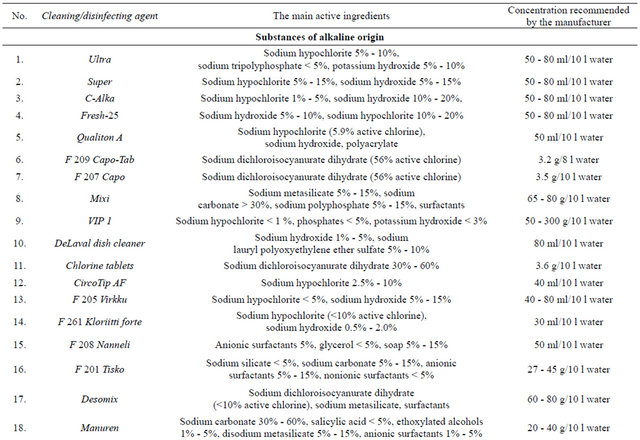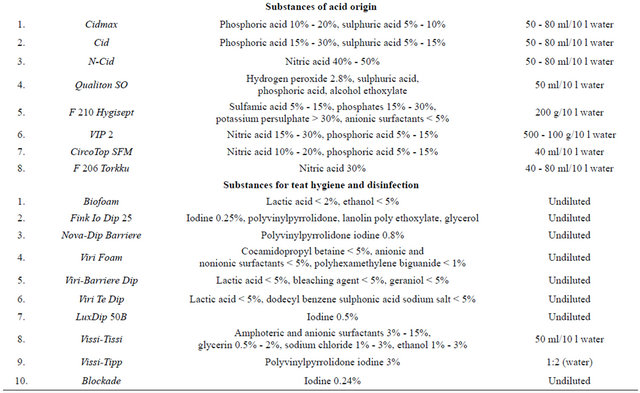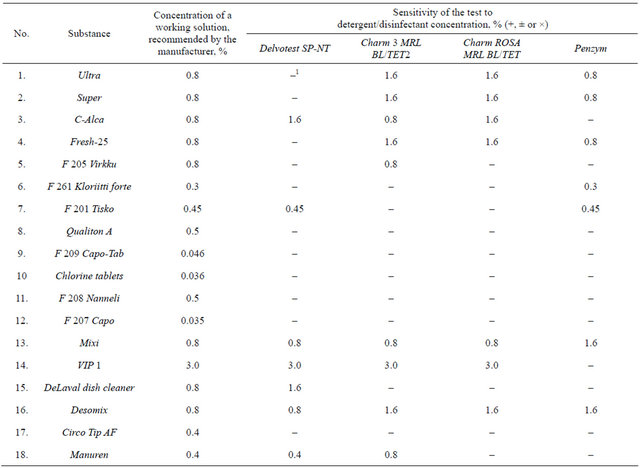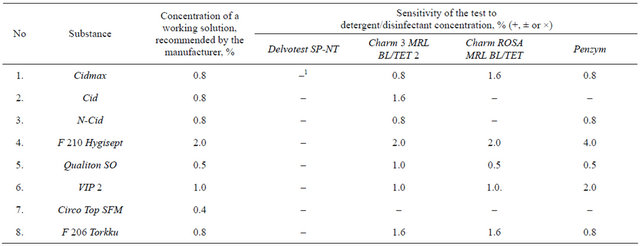Advances in Bioscience and Biotechnology
Vol.4 No.2A(2013), Article ID:28438,7 pages DOI:10.4236/abb.2013.42A036
Impact of the residues of detergents and disinfectants used in dairy farms on the results of inhibitor tests for raw milk
![]()
Kaunas University of Technology, Food Institute, Kaunas, Lithuania
Email: joana.salomskiene@ktu.lt
Received 20 December 2012; revised 20 January 2013; accepted 28 January 2013
Keywords: Detergents; Disinfectants; Residues; Sensitivity; Inhibitor Tests; Raw Milk
ABSTRACT
The aim of the study was to determine the impact of residues of detergents and disinfectants on the results of most commonly used inhibitor tests for raw milk. Microbiological test (Delvotest SP-NT) and three rapid tests (Charm 3 MRL BL/TET2, Charm ROSA MRL BL/TET and Penzym) were used in the study. Three concentrations (recommended by the manufacturer, 10 times lower and twice higher) of 36 detergents and disinfectants in raw milk were investigated. All methods did not detect concentrations of detergents and disinfectants of alkaline and acid origin 10 times lower than recommended by the manufacturer. 39% of the investigated substances of alkaline origin were detected by Delvotest SP-NT and Penzym; Charm tests showed non-typical results only. Delvotest SP-NT did not detect substances of acid origin; Penzym detected 50% of these substances, Charm tests showed only non-typical results. Delvotest SP-NT and Penzym appeared to be more sensitive to the substances used for teat hygiene and disinfection. The scope of rapid tests (receptor or enzymatic) does not cover the detection of detergent and disinfectant residues in milk. However, according to the non-typical results of the test, it is possible to suspect the presence of these substances in milk. McNemar’s and Cochran’s Q tests were used for statistical analysis of the data.
1. INTRODUCTION
Detergents and disinfectants comprise only a portion of chemical contaminants in milk. Other chemical contaminants include antibiotics and sulfonamides, pesticides, herbicides, fungicides, dioxins and mycotoxins.
Chemical contaminants possess the potential to cause toxicological harm to consumers. They can be the contributory factors in several diseases such as allergic reactions [1-8], cancer, heart disease, Alzheimer’s disease and Parkinsonism [9,10]. Residues of chlorine compounds in milk are not dangerous in this respect because of their rapid decomposition, but other disinfectants such as quaternary ammonium compounds are rather stable in milk. According to [11], the levels of these compounds (0.00001% - 0.00005%) still show a bacteriostatic action in milk. Some detergents and disinfectants as well as antibiotics and sulfonamides, can cause real risk in manufacturing cheese and cultured milk products due to reduced starter activity [12,13].
European Community legislation1 is primarily concerned with the control of residues of veterinary medicinal products. For determining of veterinary medicinal products residues (so called antibacterial substances or inhibitors) in milk, microbiological methods are most commonly used. These methods are based on the sensitivity of the test-culture (Geobacillus stearothermophilus2 or Streptococcus thermophilus3) to antibacterial substances. Microbiological methods are wide ranging. They can detect not only veterinary drugs but also some concentrations of cleaning and disinfecting substances. They are not expensive and are used as screening methods in many countries. Microbiological methods are sensitive enough to detect concentrations of antibacterial substances according to the requirements of EU legislation, but require a longer time (minimum 2.5 h) for the detection of inhibitors. Receptor and enzymatic methods are based on biochemical reactions, they are rapid (2 - 20 min), but they can detect only one to two of antibiotics or their group. Their detection area does not cover detergents and disinfectants.
The study evaluated different tests for determining inhibitors in milk. Milk with additives of 6 detergents (widely used for cleaning and disinfecting of technological equipment in dairies commercially available in 2005-2006) [14] was included as a subject of the experiment. The detergents and disinfectants used for cleaning and disinfection of milking equipment and inventory in dairy farms were not tested. All microbiological tests, 3 of them using the test-culture Geobacillus stearothermophilus (LPT, MaI-1, Copan) and 1 using a test-culture Streptococcus thermophilus (Valio T 101) were sensitive to 0.2% TAAB-1; 1.0% TAAB-2 and 1.0% PESETTI ANTIBACT and Penzym S—to 1.0% TAAB-2. Only the detergent concentrations recommended by manufacturers for washing the equipment in milk were investigated. Other rapid tests, such as β-STAR, SNAP and ROSA showed the absence of inhibitors. In some cases it was impossible to evaluate the result of the test because of abnormalities in colors or testing procedures. No more references concerning the possibility of detection the detergent and disinfectant residues in raw milk using the receptor and enzymatic (rapid) tests were found.
The aim of our research was to determine the impact of detergent and disinfectant residues used in dairy farms on the results of most commonly used inhibitor tests for raw milk.
2. MATERIALS AND METHODS
2.1. Subjects
The subjects of the experiments: raw milk with detergent and disinfectant additives commercially available in Lithuania (36 substances): 26 substances for cleaning and disinfection of milking equipment and inventory in dairy farms (18 of alkaline origin and 8 of acid origin); 10 substances for teat hygiene and disinfection.
The dilutions of detergents/disinfectants were prepared in the inhibitory free raw milk controlled prior to inhibitory substances. Three concentrations of each substance in raw milk were prepared for the experiments: 1) 10 times lower than those recommended by the manufacturer (i.e. concentration which, in practice, might occur in milk in case of technological problems); 2) concentration recommended by the manufacturer; 3) 2 times higher concentration than that recommended by the manufacturer. The last two concentrations were studied in order to estimate a test reaction. In case of the substances for teat hygiene and disinfection, concentrations 4 times lower than those recommended by the manufacturer were also used. Composition of detergents/disinfectants used in experiments is presented in Table 1.
The impact of detergent and disinfectant residues in raw milk was determined with inhibitor tests which are most commonly used in Lithuania at this time:
1) Delvotest SP-NT (DSM, Netherlands)—a wide range microbiological test with Geobacillus stearothermophilus for determination of antimicrobial residues in milk (analog to reference method ISO/TS 26844:2006)—3 h test;
2) Charm 3 MRL BL/TET2 (Charm Sciences Inc., USA)—receptor assay for detection of β-lactam antibiotics and tetracyclines in milk—2 min test;
3) Charm ROSA MRL BL/TET (Charm Sciences Inc., USA)—receptor assay for detection of β-lactam antibiotics and tetracyclines in milk—8 min test;
4) Penzym (Nitrogen Corporation, USA)—enzymatic method for detection of β-lactam antibiotics in milk—20 min test.
The tests were used following the manufacturer instructions.
2.2. Evaluation of Results
Presence of inhibitor residues “+”; presence of inhibitor residues is suspected “±”; non-typical reaction of the test “×”: color of the test after incubation does not conform to the colors given in the test scale (Penzym); control or control and experimental strips disappear (Charm tests); absence of inhibitor residues “–”.
2.3. Analysis of Data
Repeatability of testing was 3 times. All data were analyzed with the statistical SPSS 20.0 software. In all cases, the differences were considered significant at a confidence interval of 95% (p ≤ 0.05). Comparison of inhibitor tests was made using nonparametric Cochran’s Q test. Paired test results comparisons were made using McNemar’s test. Coincidence of test results was assessed by counting k (kappa) coincidence coefficient: coincidence of results is very low when k value less than 0.40; from 0.40 to 0.59—coincidence is satisfactory, from 0.60 to 0.74—high, more than 0.74—very high.
3. RESULTS
The results of the sensitivity of inhibitor tests to alkaline and acid detergents and disinfectants used in dairy farms are presented in Tables 2 and 3.
Four methods used in the research (Delvotest SP-NT, Charm 3 MRL BL/TET2, Charm ROSA MRL BL/TET and Penzym) did not detect concentrations of detergents and disinfectants of alkaline and acid origin (10 times lower than recommended by the manufacturer for cleaning the farm equipment) in milk. The results of the sensitivity of inhibitor tests to detergents and disinfectants used for teat hygiene and disinfection in dairy farms are presented in Table 4.
Table 1. Composition of detergents/disinfectants used in dairy farms.


Table 2. Concentrations of alkaline detergent/disinfectant residues in milk detected by different tests.

1Concentration recommended by the manufacturer and twice higher was not detected.
Table 3. Concentrations of acid detergent/disinfectant residues in milk detected by different tests.

1Concentration recommended by the manufacturer and twice higher was not detected.
Delvotest SP-NT and Penzym appeared to be more sensitive to the 4 times lower concentrations of some substances used for teat hygiene and disinfection: Delvotest SP-NT—to 2.5% Viri Foam and Penzym—2.5% Biofoam. Charm Rosa MRL BL/TET did not detect any substance.
Summarized results of the sensitivity of all investigated tests to the residues of detergent/disinfectant substances of alkaline, acid origin and substances used for teat hygiene and control in raw milk are presented in Table 5. Concentrations of detergents/disinfectants of alkaline origin, as recommended (for cleaning and disinfection of the milking equipment and inventory in dairy farms) by the manufacturers or 2 times higher, were detected by: Delvotest SP-NT—39% of the investigated substances; Penzym—39% of the substances (all results when the presence of inhibitors was suspected); Charm 3 MRL BL/TET2—50% of the substances (all results were non-typical); Charm ROSA MRL BL/TET—39% of the substances (all results were non-typical).
Statistical analysis made by Cochran’s test showed that different tests significantly more often (p < 0.05) gave positive or non-typical results not for the same milk samples, i.e. they were sensitive not to the same inhibitor concentrations. After comparison of paired test results by McNemar’s test statistically significant differences were found between the results received by Delvotest SP-NT and both Charm tests (p = 0.024). The coincidence between Delvotest SP-NT and any from the rest three tests was very low (k = 0.32 to 0.39). The lowest coincidence was between Delvotest SP-NT and Penzym test results (k = 0.17).
Concentrations of detergents/disinfectants of acid origin, as recommended (for cleaning and disinfection of the milking equipment and inventory in dairy farms) by the manufacturers or 2 times higher, were detected by: Penzym—50% of substances; including results when the presence of inhibitors was suspected, accounted for 75%; Charm 3 MRL BL/TET2—88% of the substances (all results were non-typical); Charm ROSA MRL BL/TET— 62% of the substances (all results were non-typical). Delvotest SP-NT did not detect any detergent/disinfectant of acid origin. This can be explained by the fact that the acidic substance got into the test cuvette together with a milk sample during the analysis therefore the color of the test medium changed into yellow, and the test showed “absence of inhibitor residues”.
Concentrations of substances for teat hygiene and disinfection 2.5% - 10% were detected by the following tests: Delvotest SP-NT—40% of the investigated
Table 4. Concentrations of detergent/disinfectant residues used for teat hygiene and disinfection in milk detected by different tests.

1Concentration recommended by the manufacturer and twice higher was not detected.
Table 5. Sensitivity of different tests to detergent/disinfectant residues in milk.

1Presence of inhibitor residues; 2presence of inhibitor residues is suspected; 3non-typical reaction of the test; 4absence of inhibitor residues.
substances; Penzym—40% of the substances (suspected results only); Charm 3 MRL BL/TET2—40% of the substances (non-typical results only); Charm ROSA MRL BL/TET—no substances were detected.
4. DISCUSION
The residues of detergents and disinfectants can occur in milk when manufacture instructions for treating of milking equipment and inventory are not followed. Chlorine residues in milk are not dangerous because of their rapid degradation, but other disinfectants, such as quaternary ammonium compounds are stable in milk and may be harmful not only for the health of consumers but also for cheese or cultured product manufactures by inhibiting fermentation processes [11]. Milk suppliers must ensure that milk delivered to dairies is free from any of the regulated substance. Antimicrobial residues cannot exceed EU MRLs limits. No one commercial test can guarantee detection limits of all these materials, though microbiological methods being wide range methods can detect many of them. The scope of rapid tests (receptor or enzymatic) does not cover detergent and disinfectant residues in milk. The findings of the study are difficult to compare with literary data, since the inhibitor tests are usually compared to each other or whether they comply with antimicrobial susceptibility (usually antibiotics) limits declared by manufacturers [15-17]. The examination of milk samples that contain detergent/disinfectant residues by microbiological methods or rapid tests can lead to false positive results, moreover, from the non-typical reaction of the test (atypical color not existing in the scale in the case of Penzym and disappearing of control or control and experimental strips in the case of Charm tests), it is possible to suspect the presence of these substances in milk.
5. CONCLUSIONS
The investigated inhibitor tests Delvotest SP-NT, Charm 3 MRL BL/TET2, Penzym and Charm ROSA MRL BL/ TET did not detect concentrations of detergents and disinfectants of alkaline and acid origin 10 times lower than recommended by the manufacturer for cleaning the farm equipment and inventory in milk.
Some concentrations of substances for teat hygiene and disinfection (2.5% - 10% in milk) were detected by: Delvotest SP-NT (40% of the investigated substances); Penzym (40% of the substances, suspected results only); Charm 3 MRL BL/TET2 (40% of the substances, nontypical results only). 2.5% of Biofoam was detected only by Penzym and 2.5% of Viri Foam was detected only by Delvotest SP-NT.
Though the scope of rapid tests (receptor or enzymatic) does not cover the detection of detergent and disinfectant residues, it is possible to suspect the presence of these substances in milk from the non-typical reaction of the test.
6. ACKNOWLEDGEMENTS
This research was supported by the Lithuanian Ministry of Agriculture.
REFERENCES
- Adetunji, V.O. (2011) Effects of processing on antibiotic residues (streptomycin, penicillin-G and tetracycline) in soft cheese and yoghurt processing lines. Pakistan Journal of Nutrition, 10, 792-795. doi:10.3923/pjn.2011.792.795
- Dayan, A.D. (1993) Allergy to antimicrobial residues in food: Assessment of the risk to man. Veterinary Microbiology, 35, 213-226. doi:10.1016/0378-1135(93)90146-X
- Dewdney, J.M., Maes, L., Raynaud, J.P., Blanc, F., Scheid, J.P., Jackson, T., Lens, S. and Verschueren, C. (1991) Risk assessment of antibiotic residues of betalactams and macrolides in food products with regard to their immuno-allergic potential. Food and Chemical Toxicology, 29, 477-483. doi:10.1016/0278-6915(91)90095-O
- Gomes, E.R. and Demoly, P. (2005) Epidemiology of hypersensitivity drug reactions. Current Opinion in Allergy & Clinical Immunology, 5, 309-316. doi:10.1097/01.all.0000173785.81024.33
- Martínez, U.Z. (2005) Health official: Clenbuterol cases rising. Mexico Edition, Miami Herald, 28. http://www.eluniversal.com.mx/miami/15989.html
- Paige, J.C., Tollefson, L. and Miller, M.A. (1999) Health implications of residues of veterinary drugs and chemicals in animal tissues. Veterinary Clinics of North America: Food Animal Practice, 15, 31-43.
- Raison-Peyron, N., Messaad, D., Bousquet, J. and Demoly, P. (2001) Anaphylaxis to beef in penicillin-allergic patient. Allergy, 56, 796-797. doi:10.1034/j.1398-9995.2001.056008796.x
- Waltner-Toews, D. and McEwen, S.A. (1994) Residues of hormonal substances in foods of animal origin: A risk assessment. Preventive Veterinary Medicine, 20, 235- 247. doi:10.1016/0167-5877(94)90085-X
- Khaniki, J.G.R. (2007) Chemical Contaminants in milk and public health concerns: A review. International Journal of Dairy Science, 2, 104-115. doi:10.3923/ijds.2007.104.115
- Riedl, M.A and Casillas, A.M. (2003) Adverse drug reactions: Types and treatment options. American Family Physician, 68, 1781-1790.
- Jepsen, A. (1962) Residues of disinfectants and antibiotics in milk: Milk hygiene. Nordisk Veterinaer Medicin, 2, 449-455.
- Jones, G.M. (1999) On-farm tests for drug residues in Milk. Virginia Polytechnic and State University, Blacksburg, 401-404.
- O’Keeffe, M. and Kenedy, O. (2007) Residues—A food safety problem? Journal of Food Safety, 18, 297-319. doi:10.1111/j.1745-4565.1998.tb00222.x
- Žvirdauskienė, R. and Šalomskienė, J. (2007) An evaluation of different microbial and rapid tests for determining inhibitors in milk. Food Control, 18, 541-547. doi:10.1016/j.foodcont.2006.01.003
- Breton, M.H., Savoy-Perroud, M.C. and Diserens, J.M. (2007) Validation and comparison of the copan milk test and Delvotest SP-NT for the detection of antimicrobials in milk. Analytica Chimica Acta, 586, 280-283. doi:10.1016/j.aca.2006.11.060
- Gaudin, V., Hedou, C., Rault, A. and Verdon, E. (2010) Validation of a five plate test, the STAR protocol, for the screening of antibiotic residues in muscle from different animal species according to European Decision 2002/ 657/EC. Food Additives and Contaminants, 27, 935-952. doi:10.1080/19440041003677483
- Stead, S.L., Ashwin, H., Richmond, S.F., Sharman, M., Langeveld, P.C., Barendse, J.P., Stark, J. and Keely, B.J. (2008) Evaluation and validation according to international standards of the Delvotests SP-NT screening assay for antimicrobial drugs in milk. International Dairy Journal, 18, 3-11. doi:10.1016/j.idairyj.2007.06.006
NOTES
1Council Directive 96/23/EC establishes the frequencies and level of sampling and the groups of substances to be controlled for each food commodity; Commission Decision 97/747/EC provides further rules for certain animal products: milk, eggs, honey, rabbits and game meat; Commission Decision 98/179/EC lays down detailed rules for official sampling procedures and official treatment of samples until they reach the laboratory responsible for analysis; Council Regulation 470/2009 (repealing No. 2377/90 and amending 2001/82/EC and No. 726/2004) laying down Community procedures for the establishment of residue limits of pharmacologically active substances in foodstuffs of animal origin.
2Reference method—ISO/TS 26844:2006 (IDF/RM 215:2006) Milk and milk products—Determination of antimicrobial residues—Tube diffusion test.
3Valio T 101, Finland.

